Original URL: https://www.theregister.com/2013/09/20/geeks_guide_bletchley_self_guided_tour/
Bletchley rebooted: The crypto factory time remembered
High commands and dirty words in German – the story retold
Posted in Geek's Guide, 20th September 2013 09:04 GMT
Geek's Guide to Britain The Battle of Britain: it was won by the RAF and pilots in Hurricanes and Spitfires assisted by a new-fangled invention called radar that gave the enemy's position away.
It was the first campaign of the World War II fought entirely in the air and was waged by Germany's Air Force, the Luftwaffe, against the UK's Royal Air Force (RAF) during the summer and autumn of 1940.
But the bit about the radar is not the whole story. The RAF command actually already knew the Luftwaffe's plans before their pilots took off from France during those long days of summer and autumn.
That’s because the encrypted communications used by the Luftwaffe – thousands of messages about flight operations and targets – had been hacked by code-breakers of Bletchley Park, just outside Milton Keynes.
I learn this nugget about the Battle of Britain on a trip to Bletchley Park, armed with the Park’s new self-guided tour - a ruggedised iPod on lanyard that comes free with the admission ticket. Drifting between the huts of Bletchley, where the code-breakers worked, I'm getting sucked in and becoming oblivious to my ever-slowing footsteps.
The iPod guide continues: working on other enemy communications, Bletchley Park's code-smashers decrypted reports that Hitler's prized battleship the Bismarck had asked for navigational charts... so that Britain could send out a pair of Supermarine Spitfires to sink it.
The code-breakers also played a crucial role in the June 1944 D-Day landings in Normandy. Bletchley's operators were among the first to learn of the German surrender and of two massive nuclear blasts in the Japanese cities of Hiroshima and Nagasaki that finally brought WWII to an official end.
All this and more was only made possible by the fact Bletchley was a massive operation: between 9,000 and 12,000 dedicated staff (numbers vary) working intensely in shifts around the clock cracking hundreds of thousands encrypted Axis military signals.
Two-thirds of staff were women, three of the staff were chess champions – recruited for their unique problem-solving abilities – and one Bletchley Parker was Alan Turing, the father of modern computer science. Slaving in the huts I now pass, their work was hot in summer, cold in winter, grindingly repetitive all year 'round, and coders burned out.
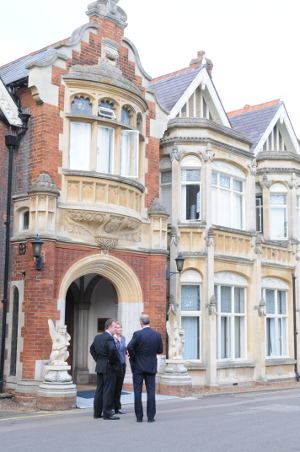
Bletchley Park manor house: where WWII de-coding began
Bletchley also saw the first computers ever used to hack crypto, called the Tunny and Colossus. The Colossus machines read 5,000 characters a second; with 10 Colossus operated by 500 staff they broke 63 million characters of "high-grade" German communications.
This story has been hidden from history. That's thanks to WWII being a narrative being shaped by gripping tales of the clash of men, the ripping of bullets and the sinking of steel. It's due, too, to the fact Bletchley was smothered into silence by the Official Secrets Act during and after the war. This place was so secret that pieces of paper stuffed into the cracks in huts' walls by those working inside, to keep out the cold winter winds, had to be removed after 1945 so that not one trace of Bletchley's wartime activities might be discovered.
This story is now packaged in the self-guided iPod tour that comes with the admission ticket. Seven hundred iPods are in stock, paid for by the Bletchley Park Trust while there were plans, when I visited, to make the guide available for download from iTunes. This hadn't yet happened. The guide and iPods come as £4.6m of Lottery Fund cash awarded to Bletchley Park in 2011 is being deployed in a major bout of renovation. That money is being spent renovating Bletchley's neglected code-breaking huts with a purpose-built visitors' centre due by next spring, too.
There are two streams to the tour – one for adults and one for kids – which are presented differently. Adults get the Jeremy-Vine like Jonathan Foyle and kids a redhead Women's Royal Navy Service (WREN) officer named "Dorothy". Foyle bestrides Bletchley while Dorothy operates behind a desk armed with blackboard, in-tray and glint in her eye. She is filmed in a scratchy, war-era cine-camera style.
Foyle packs in the facts and breaks out the veterans along with pertinent B&W clips from the war. Dorothy keeps the history bite sized, colourful and interactive.
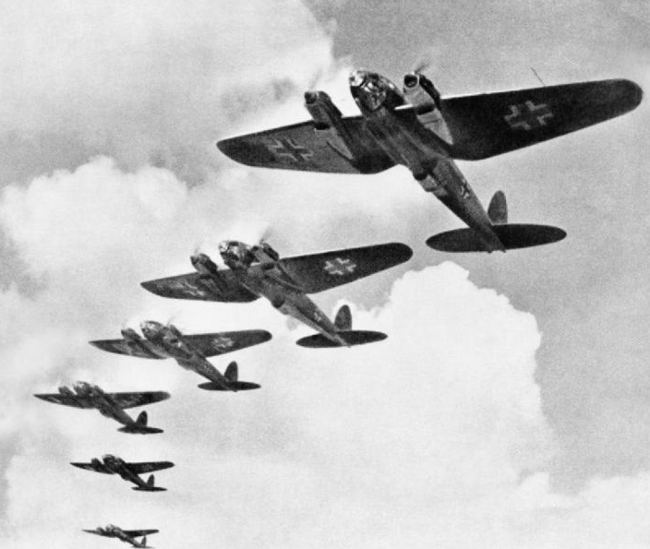
The attack plans of Hitler's Luftwaffe for the Battle of Britain were known by Bletchley
You can tap through bios on code-breakers, get explanations of things like encryption and how the German cypher machines worked, and there are also quizzes and code-breaking challenges on schoolboy staples like Morse code.
The first challenge, though, is which tour to take: adults or kids? I mix and match, in case I miss something.
I begin at Bletchley Park's manor, where British wartime code-breaking began. The Victorian pile and its grounds were bought by the government in May 1938 to serve as a base for the Government Code and Cypher School (GC&CS) - that became GCHQ - in the event of a future war. When that war came in September 1939, the operation was small – with just 200 staff and catering courtesy of chiefs from London’s Savoy Hotel.
We're introduced to the first of the Germans' fiendish encryption devices: Enigma actually dated from WWI and was used banks to to encrypt messages to help prevent fraud before it was adopted by the German military. Enigma is an electro-mechanical device in a wooden case with a keyboard and set of three to five rotors. It was the rotors that disguised a character’s meaning using a list of settings approved in a codebook. Enigma could muster a possible 159 million, million, million settings.
From brains to machines
I move out, to the rear of the mansion – the water tower and red brick and whitewashed cottages. The tower briefly hosted a radio receiver but was closed, lest its radio antenna and signal draw attention to Bletchley.
Here I learn Bletchley processed up to 20,000 messages each day from Enigma and later German machines. Messages were dispatched to London and PM Winston Churchill via motorcycle courier equipped with side arm. Later a teleprinter was used, attached to phone line – but no leaky radio signals.
These cottages initially housed Turing and mathematician Peter Twinn among others. Twinn cracked the first Enigma message for Bletchley after just four months, using brainpower and mathematical logic - the code-breaking machines Bletchley is known for had yet to arrive. His work had been informed by information given to Britain by Polish mathematicians who’d obtained Enigma machines and codes before the German army invaded their country. You’ll find a book-shaped stone memorial to the Poles in this area.
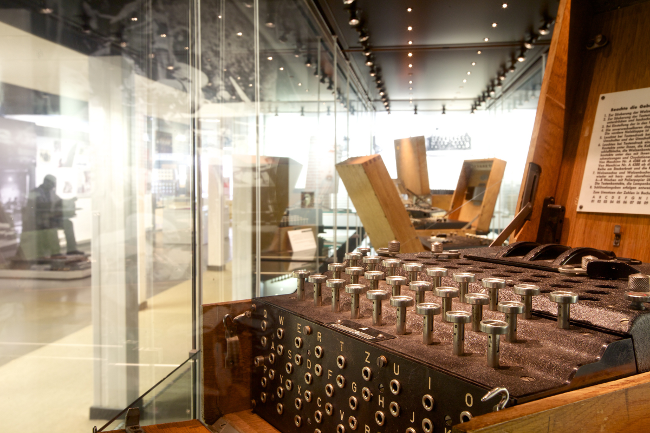
The Enigma machine: first phase in a crypto arms race
On the adults' tour, we also learn of fellow mathematician and code-breaker Gordon Welchman. He headed up Hut 6, breaking the daily settings of the Enigma machines used by Hitler’s air force during the Battle of Britain. Hut 6 sent its information to Hut 3 separated by a distance of just eight feet, where messages were translated, interpreted and dispatched. Messages were passed in Heath Robinson fashion between the huts using a wooden tray tugged along a runner via two pieces of string. The set up was built by Bletchley’s carpenters. Foyle interrupts these observations to say Hut 6 was “inundated” with German radio comms during the summer of 1940 - the start of the Battle of Britain.
It's here I get an insight into how the people breaking the codes worked. Each person was given just a fragment of each individual message – nobody ever got a complete cypher - to maintain total secrecy. “I was aware it was German codes, I was aware it was the Enigma machine, I was unaware of the content,” Hut 6 code breaker Oliver Lawn says on the guide.
All well and good, but Bletchley was under enormous pressure to speed up the decoding. The German military used Enigmas on 100 different communications networks and - to complicate things - they changed the settings of the Enigma rotors each day. The German navy, meanwhile, had gone a step further by customising its own set of Enigmas with the addition of extra rotors and an additional set of codebooks.
The answer was Bletchley’s first code-breaking machine, the Bombe, an electro-mechanical device designed by Turing and Welchman. Actually, Turing wasn't quite the invincible genius received wisdom tells us he is: Turing’s first version of the Bombe didn’t work properly when it arrived in March 1940 and it took Welchman fiddling with the wiring to get things going properly.
The Bombe looks like a telephone switchboard filled with 180 coloured drums. Each drum represented three Enigma machines. Two hundred Bombes were built but none remain – instead you can see a replica at Bletchley.
The Bombe worked by process of elimination, searching for the daily Enigma settings by looking for common phrases. Its results were fed into a separate Typex machine – a kind of typewriter operated by a human who chewed through the Bombe's results to spit out the decoded message at the other end.
Common phrases were recorded on boards, written using coloured children’s crayons that happened to be laying around at the time and that stuck – green for the army, red for the air force and blue for – yes - the navy.
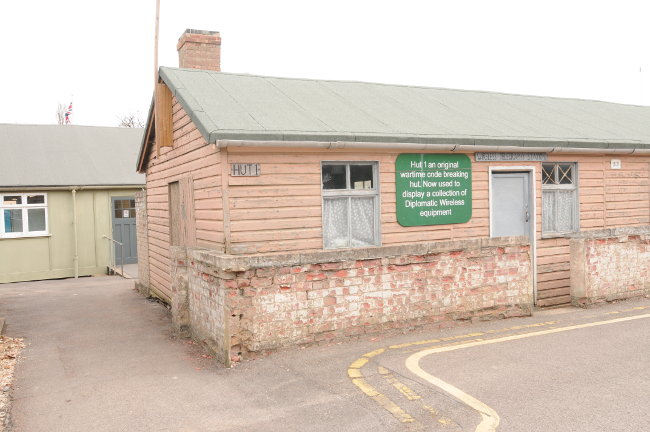
Turing's Hut 8 peeks out from behind code-breakers' Hut 1
The Bombe operators were all WRENs - they also operated the later Tunny and Colossi. WRENs connected plugs and wires to create a spaghetti junction. Then they had to simply wait for the process to stop running.
Turing, I learn, dedicated himself to cracking the German navy’s particularly fiendish flavour of Enigmas from his office in Hut 8, which you can visit. Something was missing, though: those decoding the navy's Enigmas needed the codebooks. One codebook was stolen in May 1941 and but the German navy went and added yet another rotor, making the codes unreadable again.
History took a turn in February 1942 with the acquisition of an updated codebook, and that's where the Bletchley kids’ tour out-guns the adult version. There's a Commando-comic style animation telling how German U-boat 559 was intercepted and attacked by ships of the Royal Navy and how the code books for its Enigma lifted without the German military ever finding out.
It’s a story of luck, daring and heroism as we learn that two crew from one of the warships that captured the U-boat – Able Seaman Collin Grazier and Lieutenant Anthony Frasson from HMS Petard – went back into the sinking vessel for a second tranche of codebooks but they went down with the boat when it suddenly sank. The men earned posthumous George Crosses.
It's these individual tales that come through in the guide and tell a story beyond the headlines of Alan Turing and the Colossus.
You like die 'bang, bang' with the ladies, ja?
It brings me on to the WRENs, who actually ran the code-breaking machines. The WRENs worked in extreme temperatures during summer and winter inside the wooden and then concrete huts, their work was tiring with the shifts running for eight hours around the clock seven days a week.
Bombe operator Ruth Bourne's shift-times were changed each week and that this would screw up people's body clocks. WRENs lost it. Bourne herself went to the Bletchley sick bay one day complaining of feeling “not very well” before collapsing in tears. The doc's prescription: four days sleep with a constant supply of jugs of water by her bed followed by two week’s leave. “Some didn’t recover and go back to work,” Bourne reflects.
The Germans were efficient, but they also made errors. It was their mistakes that gave Bletchley Park's operators crucial breaks in understanding the encryption and messages, as a section called "Cilli" explains. The Germans frequently used the airwaves for dirty talk about their girlfriends, giving the girls a Bletchley plenty of gossip and giggles and allowing the decoders to build up a library of recognisable – if dirty - words. It’s believed Cilli was the name of a German soldier’s girlfriend.
Germany's Italian allies were sloppy, too, typing out full words rather than disguising then - for example, “incrociatore” for cruiser. This caught the Italians out at Cape Matipan in March 1941, the first military victory credited to Bletchley Park. The Royal Navy sank three Italian heavy cruisers, two destroyers and crippled the Italian's flag ship in an action that claimed more than 2,400 Italian sailors for three British lives.
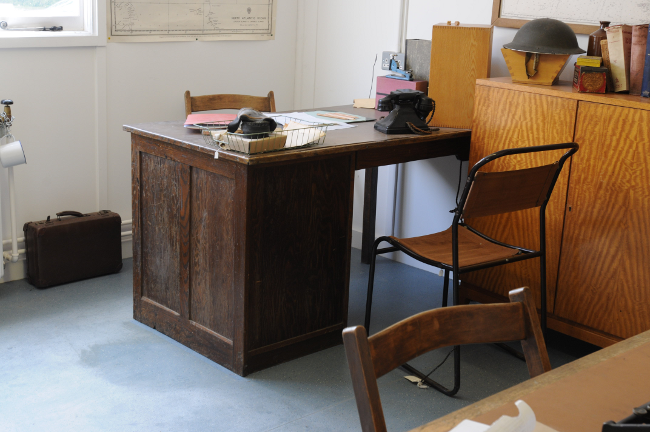
Seat, desk and hard hat of power: Alan Turing's office, Hut 8
But it was the downing of Hitler’s naval pride, the Bismarck, that's the real breath-taker. The sinking of the Bismarck was a priority: a monster ship weighing 50,000 tonnes, it had sunk the Royal Navy's HMS Hood with the loss of 1,416 crew and just three survivors picked up.
The Bismarck was big enough to menace food and supply lines to Britain coming across the North Atlantic from then-neutral North America. Sinking the ship was important not just British morale but also to the armed forces' material chances of staying alive during those dark early days of the war.
Anchored in Norway, Bismarck had slipped out to attack Allied shipping on May 18, 1941. The Naval brass didn’t believe Bletchley’s initial intercept about the ship's movements but when Bletchley decoded a second message between the ship's operators and shore that revealed Bismarck’s final destination as the French port of Brest, the navy scrambled. Three British battleships and 14 aircraft pounded the Bismarck, sinking her on 26 and 27 May, 1941.
The key piece of information that Bletchley decoded? A Luftwaffe officer named Hans Gesserlick on shore had radioed the Bismarck to inquire about the health of a family member among the crew. In this communication the ship's operators told Gesserlick of the Bismarck's destination – Brest.
Bletchley even decoded the last message from the ship's captain - "ship unmanageable, shall fight to last shell, long live the Furher" - and news of the sinking that lunchtime time producing spontaneous cheering in Bletchley’s crowded canteen (the now-disappeared Hut 2).
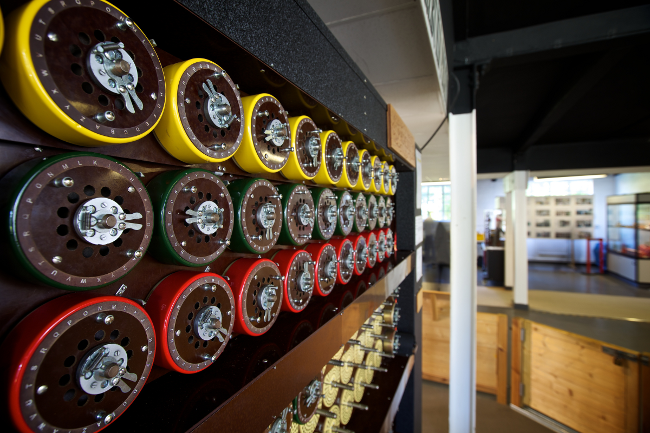
Bletchley's replica of the Turing-designed Bombe, the Park's first code-breaking machine
The guide moves me on. Bletchley is best known for the Tunny and Colossus, introduced because the Germans had upped the intelligence ante with the Lorenz SZ42 cypher machine. Lorenz messages bested the Enigma by using 12 rotors, giving it a possible 1.6 billion billion possible start positions each day. The Lorenz was used for the Hitler and his high command.
The Tunny was designed using simple deduction and inspired genius by Bill Tutte and built by scientists at the forerunner of BT, the General Post Office. Tunny, though, could only process final decrypts. The job of working out the original rotor settings was done by hand and still took days.
Colossus was built to perform numerical analysis of messages and cut the job of working out the start position of those 12 rotors to hours. The secret to Colossus was Thermionic valves – 2,500 by the time of the second Colossus in 1944. Valves were the idea of GPO engineer Tommy Flowers, who'd seen the GPO use the valves in the first, modern digital GPO phone exchanges. Between 15 and 20 Tunnys and 10 Colossi worked at Bletchley.
Colossus played a major role in the success of the Allied landings in June 1944 - the landings that paved the way to eventual victory. The Allies had been distributing false intelligence that the landings were to take place in Calais. Listening to the messages from the ambassadors of German ally Japan on troop movements and on defence plans for Northern France, Bletchley learned the German High Command had swallowed the Allied deception. With the bulk of Hilter’s defensive forces concentrated in Calais, the Allies landed 233 miles (375km) south in Normandy.
They did what around the lake?
The guide tells about Tunny and Colossus on a trip around the lake at Bletchley Park. This is a bit confusing but is explained because the machines ran in the buildings that now comprise The National Museum of Computing History (TNMOC), a few seconds’ walk from the Bletchley manor and huts. Also, they were in a hut pulled down years ago with its site now beneath a car park. You can see the rebuilt Tunny and Colossus at TNMOC.
The guide is winding up and I’ve ground to a halt by the lake.
Time for refreshments. There’s a decent Bletchley Park café, called Hut 4, tucked in next to the manor house. Hut 4 has adopted the National Trust template for refreshing the general public: spacious and well-presented, it serves hot meals, lush cakes and muffins, delicious soups – I opt for the carrot and coriander – and ready-made sandwiches. There’s not much food-wise around Bletchley, so Hut 4 than takes up the slack.
The self-guided tour takes about an hour and a half. You can either combine it with a visit to TNMOC – where you'll see those Colossus and Tunny rebuilds – or rejoin the world back in Milton Keynes (the next train stop north) and head back to London Euston in less than an hour. You could also pop over to Oxford and Cambridge, where many of the brains for Bletchley including Turing were recruited at the start of the war.
If you want to stay in the area, there’s plenty of places to stay, visit and shop at in Milton Keynes and cities of Oxford and Cambridge. If you want to stay local, though, there’s the Bletchley Park B&B.
Bletchley has a challenge. Fans of British tech will likely feel they know about the Bletchley story. Everybody else will overlook Bletchley's role in WWII thanks to the legacy of the Official Secrets Act and that dominant narrative.
But the self-guided tour changes this. It sheds new light on familiar chapters in the war and the surprising role Bletchley Park played. Moreover, the guide helps put names and faces to the people behind the more familiar Turing and behind the mighty Colossi – people without whom Bletchley couldn't have functioned as it did.
My advice: go to Bletchley and plug in. ®
GPS
51.997367,-0.742911
Postcode
MK3 6EB
Getting there
By train: between 30-50 minutes from London Euston to Bletchley. By car: between the A5 and A421, north of London.
Entry
Winter opening: 1 November to 28 February, 9.30am to 4.00pm.
Summer opening: 1 March to 31 October, 9.30am to 5.00pm.
Entrance fee: adults £15, children 12-16 £9, under-12s go free, family tickets £34.
Concessions available.
Visitors to Bletchley Park can visit the Tunny and Colossus at TNMOC. Charges are £2 for the Tunny and Colossus galleries and £5 for the whole museum. The TNMOC Colossus and Tunny galleries are open daily; the rest of TNMOC is open every Thursday, Saturday and Sunday afternoon from 1pm.